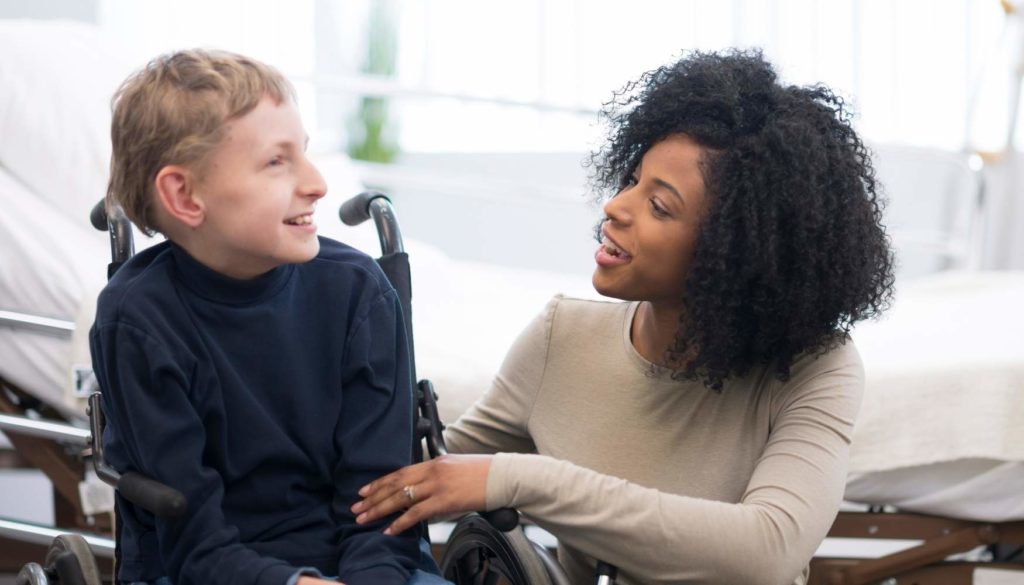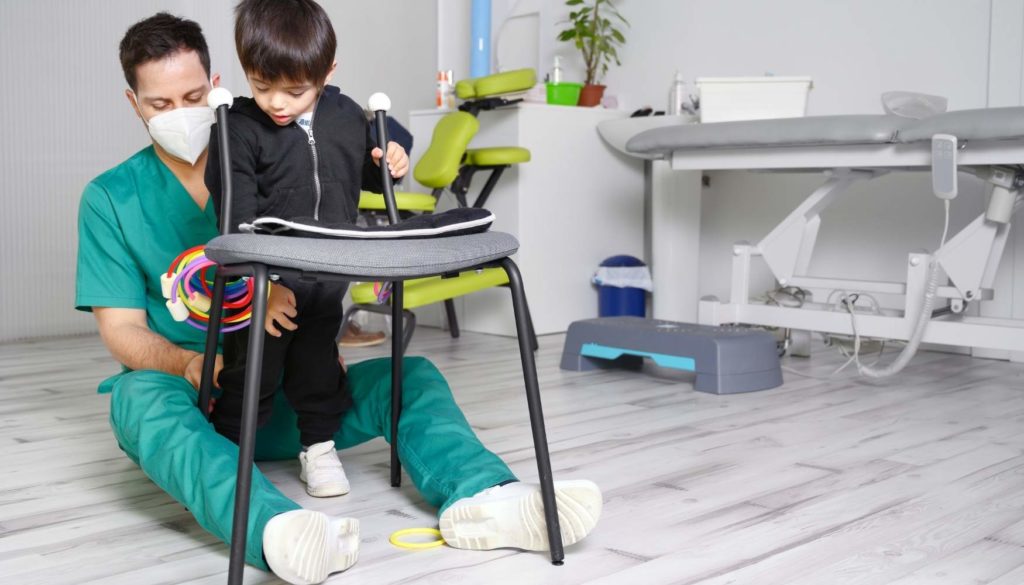Physical Therapy for Cerebral Palsy

Physical Therapy for Cerebral Palsy – Information, Exercises, and More
Cerebral palsy is a lifetime condition that affects nearly every aspect of an individual’s life.
It can be frustrating, tiring, and difficult to work through the daily treatment options to see any maintenance or improvement of pain or symptoms.
Along with a handful of other treatments, physical therapy treatment for cerebral palsy is beneficial and is often the first thing recommended by providers.
Do you have a loved one living with cerebral palsy? Learn how physical therapy treatments for cerebral palsy can help them live a strong, healthy, and happy life as independently as possible.
Contents
What Is Cerebral Palsy?
Cerebral palsy translates to “brain muscle weakness.” It typically presents with stiff legs and arms, causing issues with:
- Movement
- Posture; and
- Muscle tone
The onset of symptoms comes either before, during, or soon after birth.
It is not a progressive condition, but there is no treatment to rid a person of cerebral palsy. However, children can benefit from medication and many therapies to help them live life as normally as possible.
What Causes Cerebral Palsy?
Cerebral palsy is not a hereditary condition.
Instead, there are many risk factors during pregnancy and birth that can lead to the development of cerebral palsy.
Cerebral palsy is caused by abnormal development or damage to the developing brain in utero or during birth — known as congenital cerebral palsy, or in the early years of a child’s life while the brain is still developing.
A few children develop acquired cerebral palsy more than 28 days post-birth due to an injury of the brain from complications, such as:
- Infections (meningitis, encephalitis)
- Lack of blood flow from cerebrovascular accidents (stroke)
- Brain bleeds
- Blood vessel malformations
- Blood clots
- Heart issues; or
- Sickle cell disease
A majority — about 85-90% — of cerebral palsy is congenital due to many risk factors.
Low Birthweight or Premature Birth
Babies who are born very small or very early can have medical problems that put them at risk for cerebral palsy.
Specifically, babies weighing less than 5½ pounds, and even more so babies weighing less than 3 pounds 5 ounces, have a greater chance of developing cerebral palsy.
Similarly, babies born before 37 weeks gestation, especially babies born before 32 weeks gestation, are at a greater risk.
A pregnancy of multiples (twins, triplets, quadruplets, etc.) is also a risk factor for cerebral palsy, mostly because multiples tend to be born early and are typically smaller babies.
Assisted Reproductive Technology
Assisted Reproductive Technology (ART) is when a baby is born as a result of infertility treatment.
These babies are at a greater risk for cerebral palsy because of their increased chance of preterm delivery or multiple pregnancies.
Pregnancy Infections
Some infections have been linked to cerebral palsy, including:
- Chickenpox
- Rubella
- Cytomegalovirus
- Maternal pelvic infections; and
- Bacterial infections
Infections can increase cytokines — a protein that circulates in the brain and blood of the baby during pregnancy — which can cause inflammation and lead to brain damage.
Birth Complications
Some birth complications can disrupt a baby’s oxygen supply during birth, which can increase the chance of cerebral palsy. These include:
- Detachment of the placenta
- Umbilical cord issues; or
- Uterine rupture
Cerebral Palsy Symptoms
Most commonly, people with cerebral palsy suffer from high or low muscle tone or spasticity.
The upper motor neurons, the nerves that communicate the brain with the body to move, are located in the brain, which is affected by cerebral palsy.
These neurons become hyperactive and send too many messages — without giving the body a chance to relax.
Some individuals also experience:
- Seizures
- Bladder and bowel incontinence
- Visual impairments
- Decreased or heightened sensations of pain and touch
- Physical or intellectual developmental delays
- Oral motor difficulties; and
- Involuntary movement
There are four main types of cerebral palsy, each with its telltale symptoms.
4 Types of Cerebral Palsy
#1: Spastic Cerebral Palsy
This is identified as increased muscle tone and affects the cerebral cortex of the brain where voluntary movement is controlled. It is the most common form of cerebral palsy, affecting about 80% of cerebral palsy individuals.
There are three types of spastic cerebral palsy:
- Spastic diplegia/diparesis cerebral palsy presents with muscle tone or stiffness mostly in the legs, making walking an issue.
- Spastic hemiplegia/hemiparesis cerebral palsy affects the arms more than the legs and affects just one side of the body.
- Spastic quadriplegia/quadriparesis cerebral palsy has an overall effect on the body. The arms, legs, trunk, and face experience stiffness, affecting oral function (talking and eating), vision, hearing, and walking. Seizures are also common.
#2: Dyskinetic Cerebral Palsy
Individuals with dyskinetic cerebral palsy have issues controlling fast or slow movements with their:
- Arms
- Hands
- Legs
- Feet; and
- Sometimes face and tongues
This makes things like walking, sitting, swallowing, or talking difficult to do.
There are three subsets of dyskinetic cerebral palsy:
- Athetoid dyskinetic cerebral palsy means the individual suffers from involuntary movements that can be fast or slow.
- Choreoathetoid dyskinetic cerebral palsy is a combination of sluggish (usually fingers and face) and sudden movements (mostly fingers and toes).
- Dystonic dyskinetic cerebral palsy is slow, rotational movements of the torso, arms, and/or legs.
#3: Ataxic Cerebral Palsy
The major symptom of ataxic cerebral palsy is a lack of muscle coordination in the legs and arms. About five to 10 percent of cerebral palsy individuals suffer from ataxic cerebral palsy.
Symptoms include:
- Weak muscle tone
- Tremors
- Trouble with vision; and
- Trouble with eyesight
#4: Mixed Cerebral Palsy
Individuals with mixed cerebral palsy suffer from any combination of the three main types of cerebral palsy.
Most commonly, spastic and dyskinetic cerebral palsy pair together, but any combination is possible.
Cerebral Palsy Treatment
The three primary treatments for cerebral palsy are:
- Medication
- Therapy; and
- Surgery
Because cerebral palsy cannot be healed, the goal of treatment is to manage symptoms and relieve pain while allowing for as much independence as possible in living a healthy life.
Treatment types vary from individual to individual, depending on their:
- Type of cerebral palsy
- Level of impairment
- Co-occurring conditions; and
- Location of movement problems
Children with cerebral palsy are almost always treated by an entire team of specialists. This ensures a well-rounded and effective treatment plan to help manage symptoms.
Most often, this team of specialists includes:
- Neurologists
- Surgeons
- Therapists (behavioral, occupational, speech and language, physical)
- Developmental pediatrician
- ENT specialist; and
- Ophthalmologist
#1: Medication
Medication helps manage pain and symptoms for people with cerebral palsy, and many individuals typically have a handful of medications they take daily for their specific conditions.
Common medications for cerebral palsy include:
- Antidepressants
- Anti-inflammatories
- Anticonvulsants
- Muscle relaxants
- Benzodiazepines
- Nerve blocks
- Botox
- Baclofen
- Anticholinergics; and
- Stool softeners
#2: Therapy
A handful of different therapists could be beneficial for an individual with cerebral palsy.
They might need:
- Occupational therapy to help improve everyday tasks.
- Speech therapy to learn how to communicate effectively and improve their ability to eat, especially if their speech and oral muscles are affected.
- Physical therapy to improve independent motor function.
- Alternative therapy (acupuncture, music therapy, hippotherapy, aquatic therapy) for patients who don’t respond well to traditional therapies.
#3: Surgery
In some cases, the symptoms of cerebral palsy are so severe that a child might require surgery for treatment.
Surgery is typically done to help improve a child’s mobility, and there are three main options:
- Orthopedic surgery helps to increase the patient’s range of motion. It might also involve surgery to correct spinal curves or hip dislocation prevention.
- Selective dorsal rhizotomy is usually done in patients with severe muscle tightness in their legs.
- Single Event Multilevel Lever Arm Restoration and Anti Spasticity Surgery (S.E.M.L.A.R.A.S.S) is done to give the child’s bones and muscles a chance to grow properly.
In other instances, there might be a need for some of these common surgical procedures:
- Gastroenterology surgery to improve feeding, digestive, bladder, and bowel functions
- Audio correction to improve hearing functions
- Surgery to assist with the proper allocation of medications
- Neurosurgery to deliver muscle relaxants to the spine or decrease spasticity
- Vision surgery to correct cortical blindness, hemianopia, or strabismus
Cerebral Palsy Physical Therapy — Will PT Help?
Physical therapy treatment for cerebral palsy is almost always recommended as a first step.
Not only can a physical therapy treatment plan for cerebral palsy improve motor skills, but it can prevent movement problems from worsening.
Through a variety of exercises, physical therapy can help improve:

- Balance
- Strength
- Posture
- Gait
- Health
- Pain
- Endurance
- Flexibility; and
- Coordination
It can also help to treat:
Best Cerebral Palsy Exercises
The exact treatments and exercises done during a physical therapy session depend on each individual’s unique conditions, but improved mobility and keeping the body strong and flexible are great benefits no matter what.
Below are the best types of exercises for individuals with cerebral palsy.
Stretching
Because so many people with cerebral palsy experience spasticity, stretching is important.
When the muscles continuously contract, they pull on the joints and limit range of motion (ROM).
Stretching helps to:
- Stabilize muscle tone
- Reduce pain; and
- Maintain or increase ROM
Strengthening Exercises
Strength training helps to increase …
- Muscle power
- Flexibility
- Posture; and
- Balance
… which are all functions that can improve independent performance of daily activities.
Aquatic Therapy
When submerged in water, cerebral palsy patients feel weightless, allowing them to focus on their form without straining their joints and muscles.
The resistance of the water also helps to strengthen muscles.
How In Motion O.C. Can Help With Cerebral Palsy
Do you have a loved one suffering from cerebral palsy?
In Motion O.C. has a team of physical therapists who are trained to help.
Not only have we worked extensively with cerebral palsy patients, but we’ve helped many clients with other ailments, too.
Our physical therapists are voted #1 in the country because we work to create a treatment plan unique to every patient.
Our patients trust that we will provide exactly the care they need.
Want to see for yourself? Contact us today for more information or to book a consultation.



